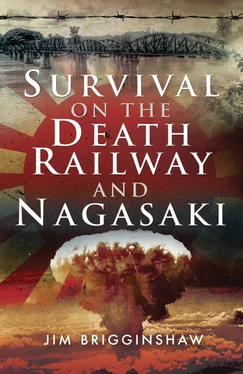Bodero and Bill Finch, the big South Australian who’d had a run-in at Mergui with a shin-kicking Korean guard, were having one of their rare smokes when there was an angry yell and a guard came bounding down from the upper deck.
‘It’s the bloody Storm Trooper!’ Bodero recognised the loathsome Korean guard they hadn’t seen since the Burma Railway days. ‘What’s he going on about? You haven’t done anything to upset the bastard, have you Bill?’
‘Last time I saw him was on the railway’, Bill said. ‘It must be something I did to him back then.’
The Storm Trooper rushed at them, swinging his rifle butt, kicking and shouting, ‘Burn ship! Burn ship!’
Only then did they realise that they weren’t using the required ashtray.
They doused their cigarettes and the Storm Trooper went away.
As the hideous days spent in stifling agony wore on, all sense of time was lost. Daytime at least gave the men their all-too-brief spells on deck, but the nights, when they were battened down, was when the cries of sick and distressed prisoners made the blackness of the airless prison more terrifying.
The cries became screams of pure terror the night the Awa Maru was rocked by loud explosions. The ship shuddered violently and from above came shouting and the sound of feet stampeding on the steel deck.
Further explosions followed, and the men knew their prison was being bombed or torpedoed by their own forces. In pitch blackness, packed into the locked hold like sardines, there was no escape. If water came flooding in, they’d drown like rats.
However, no water came, and there were no more explosions. When the throb of the engines continued, the prisoners started to breathe again. The ship was still afloat and moving.
Suddenly, some sailors removed the hatch covers that confined the prisoners. The frightened men fought to get out.
Up on deck, it was daybreak, about six o’clock, and the scene was chaotic. A Japanese oil tanker that had been about four hundred yards away on the starboard side was now behind the Awa Maru , burning fiercely. Other ships, some on fire, were wallowing in the swell while a couple of Japanese destroyers darted anxiously back and forth. The remaining ships in the convoy were scattered far and wide.
The Awa Maru had been hit in the bow by a torpedo that had blown away almost the entire front of the ship. Only the watertight bulkhead had saved it and its locked-up human cargo from going to the bottom.
What was left of the convoy, helped by a cover of rain squalls and heavy snow, made for the Chinese coast at full speed to escape the attacking American submarines. There, the ships hugged the shoreline so close that the prisoners could see the mast and superstructure of sunken vessels protruding from the water. They took some comfort from the thought that the ships lying on the bottom could have been put there by the Allied bombers that had passed overhead while they were at Tamarkan.
Much later, they were to learn that soon after Japan Force left Tamarkan, the planes attacked the bridge over the river, demolishing several of its steel spans and blowing the ack-ack guns sky high.
As the Japan-bound convoy headed further north it continued to be shielded by bad weather. The prisoners had no idea where they were until one day when they were on deck they saw the clear blue sea suddenly change to a dirty brown. For miles the ship travelled through this, and then suddenly the water was blue again. They knew then that they had passed through the muddy waters that poured into the sea from the Yangtze Kiang, the Yellow River of China.
As they drew closer to Japan, the prisoners were ordered to undergo tests to determine the degree of dysentery infection among them. The Japanese wanted to assess how much of the disease they were importing to their homeland.
The men remembered the previous method of taking faeces samples using a hooked piece of wire. This time though, the Japanese used a thin glass tube. The testing was done on deck while snow was falling. The prisoners had little clothing, and shivered as they waited in line for their turn.
Nobody expected to be told the result of the tests, and they weren’t. For the many who had dysentery, there was no treatment.
Jim Bodero was no longer passing blood, and seemed to have recovered from the near disastrous dysentery attack he’d suffered while working on the Burma Railway.
The Awa Maru and the other ships continued north and then changed course. It seemed to the confined men that they had rounded the Korean coastline and were on the last leg to Japan.
Soon they were passing through line upon line of flimsy bamboo rafts, anchored in rows a few hundred yards apart. On the bamboo deck of each raft was a huge wicker basket to hold any fish that were caught. Each raft carried a man fishing with a handline. Snow was falling, but the fishermen wore only singlets and shorts. The prisoners wondered how these men could survive the freezing nights in such skimpy clothing on rafts open to the weather. They received their answer when they saw a mother ship picking up the fishermen and their catch before nightfall.
The raft fishermen settled any doubts the prisoners may have had about the stoicism of the Japanese.
The Awa Maru passed other craft towing floating bundles of bamboo. Each bundle was tied to another, forming a long chain that was being brought from Korea to Japan by a method that didn’t take up space on a cargo ship that was needed for more vital supplies. In Japan, the bamboo would be used for everything from building houses to irrigation pipes.
On 16 January 1945, exactly one month after the convoy left Singapore, the battered Awa Maru sailed into Moji harbour on the northern tip of Kyushu, one of the main islands of Japan.
As the men filed off the ship, they were watched by their sadistic Korean guards. They didn’t know it at the time, but it was to be the last time they were to see them.
Haroishi was the only Korean guard for whom the prisoners had any liking. Haroishi, who made much of the fact that he was a confirmed Christian, had been with the prisoners in Singapore, throughout Burma, Siam, back to Singapore, and now in Japan. He had a good command of English, never committed any acts of hostility or viciousness and would often provide small favours. His kindnesses were such that the prisoners regarded him as a friend. They wished more of the Korean guards had found Christianity as he had.
Now, as they disembarked from the ship at Moji, Haroishi stood beside the gangway, apparently to give them a friendly farewell, but as each prisoner passed, he kicked him in the shins. The heaviest kicks were reserved for those with bandaged, ulcerated legs.
The men couldn’t believe the change. Then it dawned on them that Haroishi’s previous behaviour towards them in Burma was a calculated plan aimed at self-preservation. If the Allies won the war, he’d be remembered as a good Christian who had treated the prisoners well, thus making him safe from reprisals. Now that they were on Japanese soil and he wouldn’t see them again, he had no need to keep up the pretence.
The prisoners added Haroishi’s name to their hate list.
From the ship, they were marched to a parade ground where they were lined up and ordered to take off their clothes. It was freezing, but the tattered scraps of clothing they wore weren’t keeping out much of the cold anyway.
The men stripped and stood naked in the snow that was now falling heavily.
The Japanese guards ordered them to exercise. Crowds of Japanese civilians, both men and women, stood around the parade ground laughing and jeering as the shivering, emaciated, naked prisoners waved their skinny arms and jumped about.
Читать дальше












